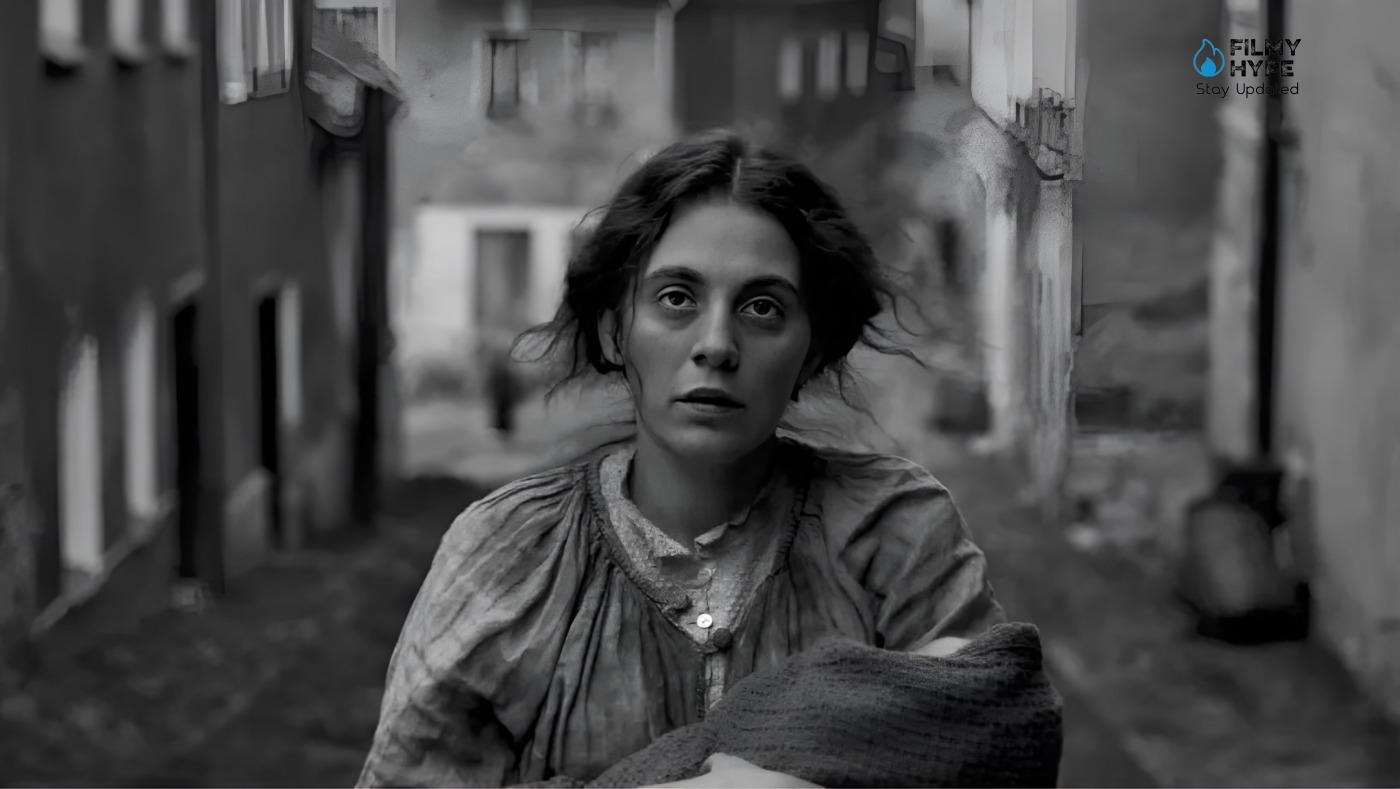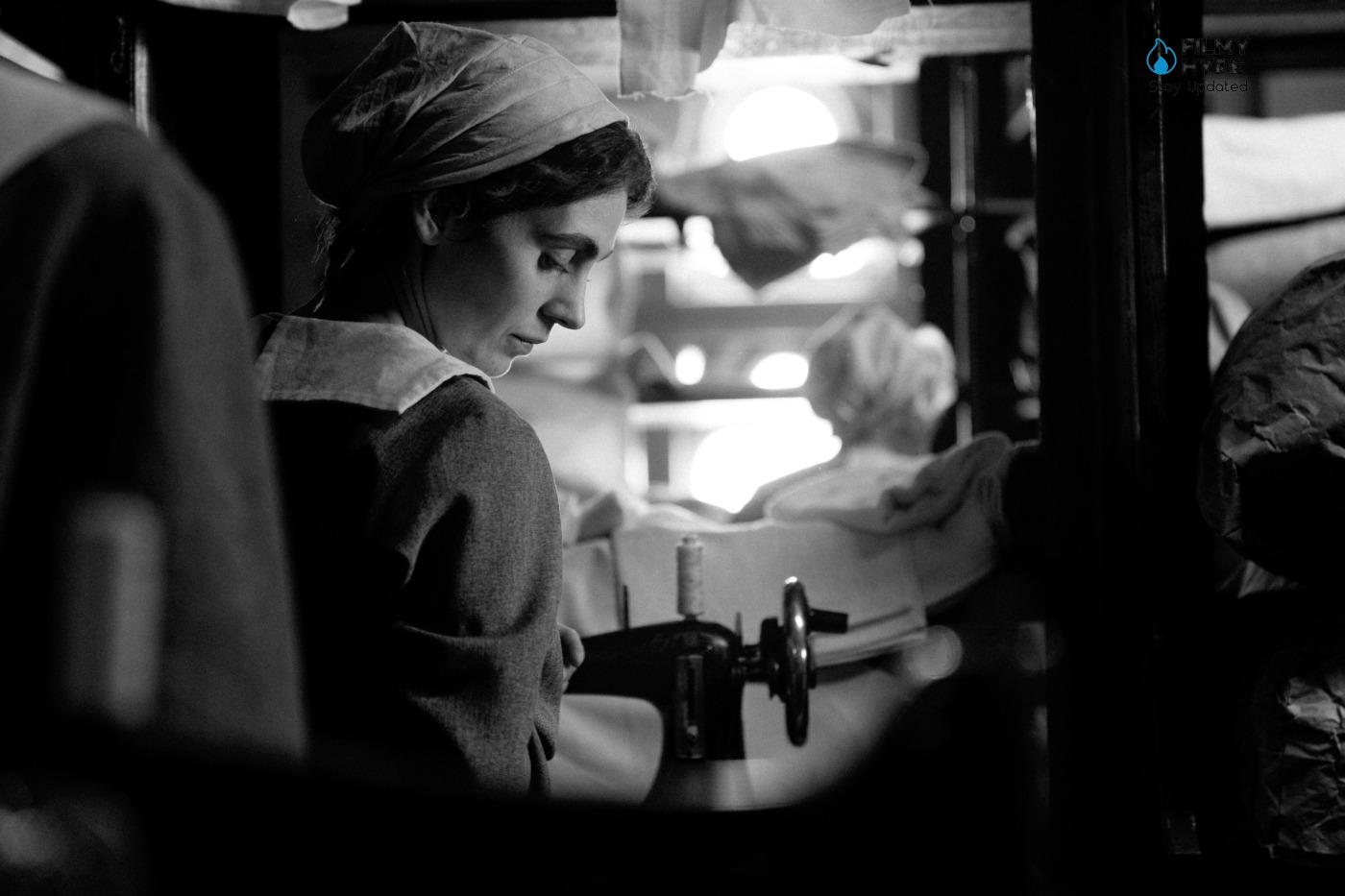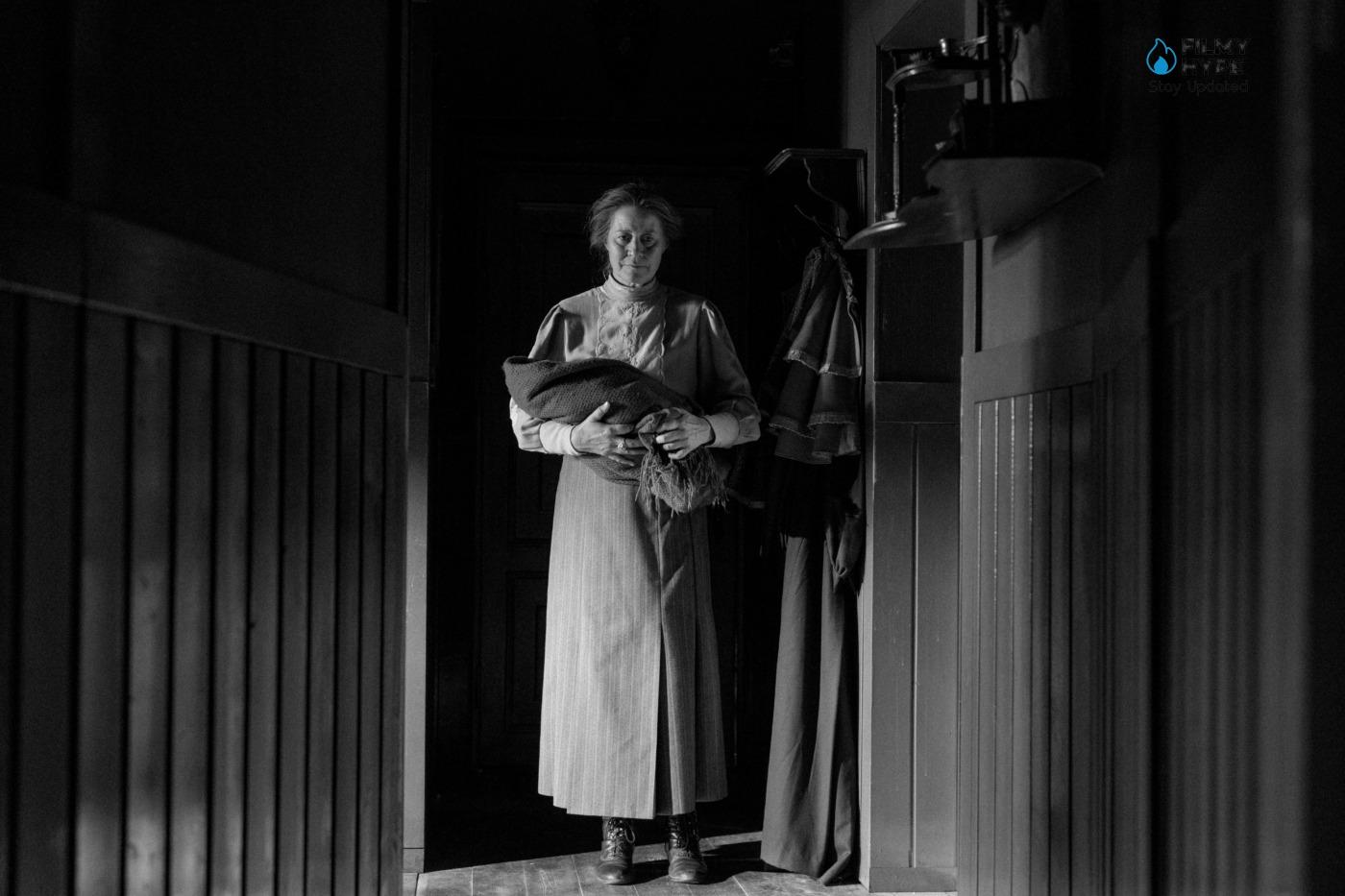The Girl with the Needle Review: A Terrifying Feminist Black Fairy Tale | Cannes 2024
Cast: Vic Carmen Sonne and Trine Dyrholm
Director: Magnus von Horn
Where we Watched: at the Cannes Film Festival
Filmyhype.com Ratings: 4/5 (four stars)
The Girl with the Needle is a disturbing, powerful, brutal, and beautiful film from a formal point of view. Above all, the one presented by director Magnus von Horn at Cannes 2024 is a feminist film in its most real, profound sense, most distant from fashions and easy rhetoric, and also has the merit of making us aware of a figure, that of Dagmar Overbye, which deserved to end up in a wide-ranging film like this a long time ago. Certainly not an easy film, not a film for faint hearts, which confirms how Nordic cinema knows how to go where few others dare today. The heart of this story is unwanted motherhood, forced by a society that does not accept any other path for women. While following the story of Karoline, a woman who is expecting a child from a man who is not her husband, the central element of the narrative is Dagmar, a character who existed and is recognized as one of the first female serial killers in Northern Europe.

The Girl with the Needle is inspired by true events relating to the most controversial murder case in Danish history. A national trauma that echoes over time and still reminds us today what it means to turn a blind eye to the horrors that are perpetrated daily in the world. In telling about the unwanted and what is best to do with them, von Horn chooses to make this film “a fairy tale for adults“, one in which one can encounter cowardly princes, monsters with a heart of gold, and evil witches. A fairy tale to tell the truth, therefore, as this genre has often shown us it can do. But not so much from a thematic point of view, which remains more or less unchanged, but rather in style, ambitions, and capacity for dialogue with the present. His new film is a real black-and-white nightmare which, between historical drama and expressionist horror, proves to be current.
The Girl with the Needle Review: The Story Plot
The Girl with the Needle is set in a poor, muddy Copenhagen, close to the end of the First World War, and has as its protagonist Karoline (Vic Carmen Sonne), a young girl who is forced to break her back like many others in a textile industry, experiencing the limits of poverty. Karoline, I haven’t heard from her husband Peter (Besir Zeciri), missing in action, for more than a year. Young, and attractive, she enters into a relationship with Jorgen (Joachim Fjelstrup), the factory director, elegant, kind, and sensitive. However, when she becomes pregnant, she discovers that the person she thought was the real Prince Charming has no intention of becoming involved with her and so, in desperation, she tries unsuccessfully to have an abortion. His path will cross that of Dagmar (Trine Dyrholm), who, however, also carries out another activity in her sweet shop, in total illegality: she works to help many girls who have become pregnant and without great prospects, finding new adoptive families.

For Karoline, it seems like the best solution, and soon she and Dagmar will bond a lot, but what seemed to be an opportunity to change their lives will soon turn out to be an atrocious nightmare. The Girl with the Needle made a big impression on the Croisette among the international press, certainly warmer than the Italian one, as has been the practice for years when it comes to dealing with Nordic productions, which have taken on difficult stories, of a cinema as refined in terms of aesthetics as it is extreme in the use of violence and the themes addressed. In this, Magnus von Horn, more than a revolutionary, is the continuer of a path that a few years ago had another object of contention in The Painted Bird, and his film is an important chapter that should not be underestimated.
The Girl with the Needle Review and Analysis
From the beginning, The Girl with the Needle is connected to an oppressive atmosphere, where the theme of monstrosity, of physical and moral deformation, reigns supreme, also being enhanced by a simply sensational photograph by Michal Dymker, with a white and crazy black, which almost becomes an added protagonist in the hands of Magnus von Horn. His direction is refined and very intimate, he essentially spares nothing for the spectator, who finds himself dealing with a dark fairy tale, where the extraordinary interpretation by the two protagonists takes center stage. Sonne and Dyrholm guide us into a whirlpool of amorality and cruelty, which is the chronicle of one of the most disturbing serial killers in Europe, whose story profoundly affected Danish society of that era.
The Girl with the Needle connects to German expressionism, the cinema of Ingmar Bergman, and the Danish school, with the horror that is suggested, and heard, it is the door to a hell that reigns in this world of the living, which stimulates the worst than the imagination of a spectator, forced to witness a degeneration which is also and above all collective. The Girl with the Needlepoints the finger at society, where women are worth nothing, they are cannon fodder, chained to a motherhood that is pure suffering and fatigue, with mothers who have become such against their will, daughters who are a burden, a symbol of universal unhappiness. Mangus von Horn shows us all this perfectly, even despite a final part that is perhaps too elongated, too mannerist, where however Dyrholm dominates.
A long-time champion, she gives us a terrifying manipulator, a chilling ogre with her determination and lack of empathy, one of the best female cinematic nemeses we’ve seen in recent years. At Cannes 2024 The Girl with the Needle was welcomed with great favor by international critics, it could have its say on very important awards. But even if this were not the case, it remains a feminist film in the historical sense and with clarity of analysis, a work that cannot leave us indifferent, which reminds us how the female body, for better or worse, remains the battlefield for the worst social morality. As we anticipated at the beginning, the language chosen by Magnus von Horn to tell a story – a true one – which is already quite disturbing in itself is that of horror. The film is enriched with horrifying suggestions of all kinds, aided by sound and photography perfectly designed to amplify the sensations (mostly of discomfort) felt by the spectator.

The men in this film are transformed into deformed and monstrous beings, the women – Dagmar in particular – into fairy tale witches ready to steal children from their mothers’ arms, ripping them from their cradles. In some scenes the woman changes, becoming a nightmarish bird of prey driven by dark intentions. While making her embody “evil” in this story, it is not against Dagmar that Magnus von Horn lashes out, but against society, that of yesterday and that of today, in which women are denied the freedom to decide about their bodies and in where extreme solutions are sought. It’s easy to lull yourself into the idea that once these children come into the world, they will live better lives, that they will find families who love them and who will raise them as they deserve, but they will probably live the same lives of abandonment and hardship as their mothers, carrying on a sad circle vicious. The interpretation proposed by von Horn is that of a single true culprit: a monstrous and engulfing society, which gives birth to victims that it then does not take care of.
Bearing the weight of such a complex story are its two protagonists, Vic Carmen Sonne’s Karoline increasingly tried and embittered but endowed with a truly particular charm, and Trine Dyrholm ‘s Dagmar, a character convincing in her ambiguity. There are elements of the plot that could have been explored differently, in particular Dagmar’s background, but once this and other details have been removed, the story works and impresses: even those who won’t like Magnus von Horn’s film (it’s not a works for all palates) cannot help but be deeply impressed, wondering how today’s society is the result of that of the past. Also in this case an unwanted but unfortunately forced motherhood. In addition to princes, monsters, and witches, like all fairy tales, The Girl with the Needle also presents us with a protagonist who is the victim of a desperate existence, marked by poverty caused by war and eviction that she doesn’t know how to remedy.
But this is only the beginning of the misfortunes for Karoline, who while the world seems to be rekindled with hope with the end of the conflict, she instead finds herself experiencing a progressive descent towards hell, guilty of naivety and unconscious connivance with evil. An evil that is a direct consequence of the upheavals that occurred in those early years of the twentieth century, and which cast a long and dark shadow over the rest of the century. The path that the protagonist takes in the film is therefore that of a woman who, mistreated and abandoned, finds herself dealing with a society and a humanity incapable of managing the neuroses that emerged after the years of war. Although the end of the conflict seems to open up a better future, the horrors known – more or less directly – cannot be erased from memory or the body, and orienting oneself in this context becomes more difficult than ever. It is from this confusion that violence draws nourishment, even that which is perpetrated with apparently merciful ends.
Karoline and the many unfortunate newborns who pass through her arms are therefore the victims of a society no longer able to take care of them and which therefore wonders what to do with their lives. The condition narrated in The Girl with the Needle seems to be too brutal to be part of our contemporaneity, but it is sufficient to read the increasingly numerous and sad news regarding the laws against abortion, the rights that one thinks one has over the body of women and in general on the inadequacy of support for parenthood to realize that what is narrated in the film is dramatically current. The Girl with the Needle, given these contents, proves to be a distressing, sometimes unbearable vision, which combats the possible indifference of the viewer by using such a raw realism that it is difficult if not impossible to feel distant from it. von Horn works on very rigorous reconstructions of the sets and costumes, obtaining an absolutely convincing staging of this story and its context.

Finally, the director of photography Michał Dymek, conceives images of extraordinary beauty, photographed with a very lucid black and white which at times recalls that of the film Roma by Alfonso Cuaròn. It is with this aesthetic refinement that he carries out his film, remaining close to reality and then flowing – at the right moment – into pure horror, with the consequent transfiguration of places and faces. However, there are moments in which one has the impression that the director goes too far in this aestheticized depiction of pain and horror, giving rise to a series of moral doubts in this regard. Fortunately, these sensations are predominantly felt in the first part of the film, while in the second, almost as if the devotion towards the story increased, the value of what is narrated is brought to the foreground. The Girl with the Needle therefore progressively finds a balance between its story and its staging, spreading its warnings with the right force. We can thus reach an ending full of emotions, of dismay, but in which a small but significant glimmer of hope unexpectedly makes its way.
Because even if you can close your eyes, it is much more difficult not to listen to the cry of desperation. Sooner or later we are then called to make choices and when faced with those who practice the harsh law of survival, a sincere act of human protection is all that is needed to build the possibility of a different future. Inspired by a real news story – there are no monsters in our imagination that have not already found asylum in reality – the film confirms von Horn’s predilection for the phenomenological investigation of society and, while the story is freed from the codes of the thriller in custom, reveals the brute reality of classes and the inexorable drama of poverty. It is not the suspense that interests him nor the mystery of evil, personified with diabolical elegance by Trine Dyrholm. If anything, it is the tangible clues of the material and moral decay of the world – the hypostasis of light of an earthly theodicy – entrusted to work as superb as it is mannerist on photography, that moves von Horn’s gaze and somehow traps it in an allusive web and seductive with beautiful images. Not to find grace in squalor but a hint of satisfaction.
The Girl with the Needle Review: The Last Words
The Girl with the Needle is a terrifying story: using the stylistic elements of horror cinema it points the finger at the society of today and yesterday. The Girl in the Needle drags its viewers into a story that can reach levels of anguish and horror that are difficult to sustain. A real nightmare, set in the past but with a story whose echoes continue to this day, warning against a society that does not take care of its women and children. Seeking more aesthetic effect than narrative substance. A cinematographic chain that lives by making the drama that dominates the story vibrate (perhaps more than necessary), shaping the image following the canons of an aesthetic probably conveyed by a strong mannerism.

The Girl with the Needle Review: A Terrifying Feminist Black Fairy Tale | Cannes 2024 | Filmyhype

Director: Magnus von Horn
Date Created: 2024-05-19 16:04
4
Pros
- The protagonists are truly convincing and magnetic
- The film wisely uses the stylistic elements of horror cinema
- Music and photography are spot on
Cons
- The background of the characters perhaps should have been explored better
- Sometimes the author's message struggles to get through

